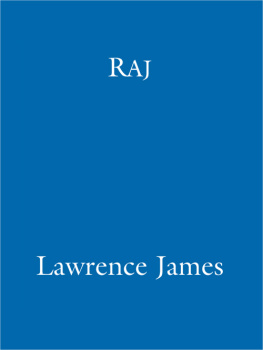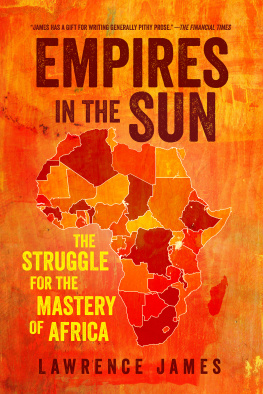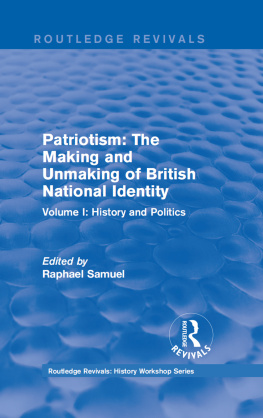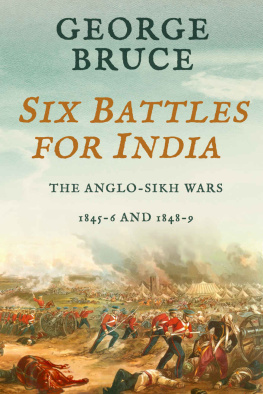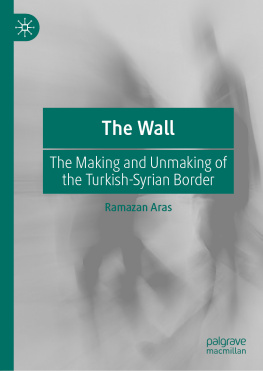Lawrence James - Raj: the making and unmaking of the British India
Here you can read online Lawrence James - Raj: the making and unmaking of the British India full text of the book (entire story) in english for free. Download pdf and epub, get meaning, cover and reviews about this ebook. year: 2010, publisher: Little, Brown Book Group, genre: Politics. Description of the work, (preface) as well as reviews are available. Best literature library LitArk.com created for fans of good reading and offers a wide selection of genres:
Romance novel
Science fiction
Adventure
Detective
Science
History
Home and family
Prose
Art
Politics
Computer
Non-fiction
Religion
Business
Children
Humor
Choose a favorite category and find really read worthwhile books. Enjoy immersion in the world of imagination, feel the emotions of the characters or learn something new for yourself, make an fascinating discovery.
- Book:Raj: the making and unmaking of the British India
- Author:
- Publisher:Little, Brown Book Group
- Genre:
- Year:2010
- Rating:3 / 5
- Favourites:Add to favourites
- Your mark:
- 60
- 1
- 2
- 3
- 4
- 5
Raj: the making and unmaking of the British India: summary, description and annotation
We offer to read an annotation, description, summary or preface (depends on what the author of the book "Raj: the making and unmaking of the British India" wrote himself). If you haven't found the necessary information about the book — write in the comments, we will try to find it.
Raj: the making and unmaking of the British India — read online for free the complete book (whole text) full work
Below is the text of the book, divided by pages. System saving the place of the last page read, allows you to conveniently read the book "Raj: the making and unmaking of the British India" online for free, without having to search again every time where you left off. Put a bookmark, and you can go to the page where you finished reading at any time.
Font size:
Interval:
Bookmark:
Lawrence James studied History and English at York University and subsequently undertook a research degree at Merton College, Oxford. Following a career as a teacher, he became a full-time writer in 1985, and is the author of The Golden Warrior: The Life and Legend of Lawrence of Arabia; Imperial Warrior: The Life and Times of Field Marshal Viscount Allenby; and the acclaimed The Rise and Fall of the British Empire.
He now lives in St Andrews, where his wife is headmistress of St Leonards School, with their two sons.
Crimea: The War With Russia in Contemporary Photographs
The Savage Wars: British Campaigns in Africa 18701920
Mutiny: Mutinies in British and Commonwealth Forces 17971956
Imperial Rearguard: The Last Wars of Empire
The Golden Warrior: The Life and Legend of Lawrence of Arabia
The Iron Duke: A Military Biography of the Duke of Wellington
Imperial Warrior: The Life and Times of Field Marshal Viscount Allenby
The Rise and Fall of the British Empire
Published by Hachette Digital
ISBN: 978-0-748-12533-3
All characters and events in this publication, other than those clearly in the public domain, are fictitious and any resemblance to real persons, living or dead, is purely coincidental.
Copyright 1997 by Lawrence James
All rights reserved. No part of this publication may be reproduced, stored in a retrieval system, or transmitted, in any form or by any means, without the prior permission in writing of the publisher.
Hachette Digital
Little, Brown Book Group
100 Victoria Embankment
London, EC4Y 0DY
www.hachette.co.uk.
To Nick and Jane Roe
PART ONE
THE COMPANY ASCENDANT: 1740 84
PART TWO
THE CONQUEST OF INDIA: 1784 1856
PART THREE
THE RAJ CONSOLIDATED: 1784 1856
PART FOUR
THE MUTINY: 1857 59
PART FIVE
TRIUMPHS AND TREMORS: 1860 1914
PART SIX
DISTURBANCES AND DEPARTURES: 1914 48
I would first like to thank my wife, Mary, for her forbearance, patience and good humour during the preparation and writing of this book. Thanks are also due to my sons, Edward and Henry, who have provided many valuable services. Help, suggestions, advice and information were also provided by Vice-Admiral Manohar Awati, Dr Richard Boyden, Dr Ian Bradley, Geordie Burnett-Stuart, Mrs Elsie Butler, William Dalrymple, Richard Demarco, Dr and Mrs Martin Edmonds, Sir Gerald Elliot, Professor Ray Furness, Dr Nile Gardiner, David Gilmour, Andrew Gordon, Ruth Guilding, John Hailwood, Robert Harvey, Mr and Mrs Guli Juneja, Professor Bruce Lenman, Andrew Lownie, Philip Mason, Michael Mates, Lieutenant-Colonel David Murray, Professor Alan Pat, Liz Pert-Davies, A-Rajagopalan, Professor Jeffrey Richards, the late General Sir Ouvry Roberts, Professor and Mrs Nick Roe, Trevor Royle, Buddahev Saha, Alan Samson, Dr Bill Shields, Linda Silverman, W. A. Simms, Captain James Squire, Emma Strouts of Christies Images, Deepak Vaidya, Andrew and Cherry Williams and Andrew Wilson.
I am greatly indebted to the staff of St Andrews University Library and the India Office Library for their courtesy and efficiency in handling all manner of enquiries. I would also like to thank the staff of the British Library, the National Library of Scotland, the Bodleian Library, Strathclyde Record Office, the Scottish Record Office, the National Army Museum, the Imperial War Museum, the Public Record Office and the Ministry of Defence. All have been generous with their time and knowledge.
Quotations from Crown Copyright collections appear by permission of the Controller of Her Majestys Stationery Office, and those from the papers of General Sir Richard Savory by kind permission of his Literary Trustees.
Picture Credits
SECTION ONE
1, 4, 7, 8, 9, 10: The Hulton Getty Picture Collection; 2: Popperfoto; 3: Christies Images; 5: Trustees of the Blair Athol Estate; 6: Victoria & Albert Museum; 11, 12, 17, 18: India Office Library; 15, 16: Courtesy of Deepak Vaidya
SECTION TWO
1, 12: Popperfoto; 6: Christies Images; 8: Trustees of the Blair Athol Estate; 11: The Hulton Getty Picture Collection; 16, 17, 18, 19, 20: Courtesy of Geordie Burnett-Stuart; 21, 22: Imperial War Museum
SECTION THREE
1, 2, 3: Courtesy of Geordie Burnett-Stuart; 5, 6, 10, 11, 12, 15, 17: The Hulton Getty Picture Collection; 9: Camera Press; 13, 14: National Army Museum; 16, 18: Popperfoto

A SCENDANT:
1740 84

Twilight
I
I ndia is a land of vanished supremacies. Each proclaimed its power and permanence by architecture on the grand scale, designed to inspire admiration, awe and even fear. Always the observer is compelled to look upwards. One cranes ones neck to see the strongholds of Rajput warlords, perched precariously on the hilltops of Rajputana (Rajasthan), and one stands back to view the great mosques and mausoleums of their overlords, the Mughal emperors. Approach requires a degree of supplication; one trudges up the hillside to reach the Jaipur maharajas palace at Amber and vast flights of steps skirt the government offices of the British Raj in New Delhi. The overall impression is of a country where power has been concentrated in a few hands and always flowed downwards.
There is much truth in this. The public buildings of the Mughals, the Indian princes and the Raj were expressions of their authority, reminding the onlooker of his place in the scale of things. Wealth went hand in hand with political power; the elaborate and intricate marblework, jewelled inlays and painted panels which decorated mosques and palaces announced their patrons and owners as men of infinite richness. The British were more cautious about this sort of ostentation. Sir Edwin Lutyens, the mastermind behind that complex of official buildings which was to form the heart of imperial Delhi, considered traditional Indian architecture too florid and therefore unsuitable for a regime whose chief characteristics were integrity and firmness. Like other, earlier architects of the Raj, he preferred to assert its supremacy with solid stonework and severe classical motifs, which was understandable given that they and their patrons saw Britain as the new Rome. The fashion had been set in the early 1800s by the Marquess Wellesley, who believed that the dignity of a Governor-General of Bengal required a colonnaded mansion in the contemporary Georgian neo-classical style. Opposite his austere but imposing Government House was a triumphal arch surmounted by a vigilant imperial lion, which soon became a popular roost for Calcuttas cranes, vultures and kites.
Indias official architecture was a backdrop for the traditional public rituals of state. The formal processions in which a ruler presented himself to his subjects and undertook his devotions, and the durbars (assemblies) where great men met, exchanged gifts and compliments and discussed high policy, required settings appropriate to what was, in effect, the theatre of power. At the heart of the Emperor Shahjahans great palace in Delhi, now called the Red Fort, are the great audience halls, one a vast open courtyard, the other enclosed and reserved for foreign ambassadors and other elevated visitors. Both are now stripped of their awnings and wall-hangings and the private chamber lacks the Peacock Throne, a stunning construction of gold and jewels surmounted by a golden arch and topped by two gilded peacocks, birds of allegedly incorruptible flesh which may have symbolised not only the splendour of the Mughals but also their durability.
Next pageFont size:
Interval:
Bookmark:
Similar books «Raj: the making and unmaking of the British India»
Look at similar books to Raj: the making and unmaking of the British India. We have selected literature similar in name and meaning in the hope of providing readers with more options to find new, interesting, not yet read works.
Discussion, reviews of the book Raj: the making and unmaking of the British India and just readers' own opinions. Leave your comments, write what you think about the work, its meaning or the main characters. Specify what exactly you liked and what you didn't like, and why you think so.

